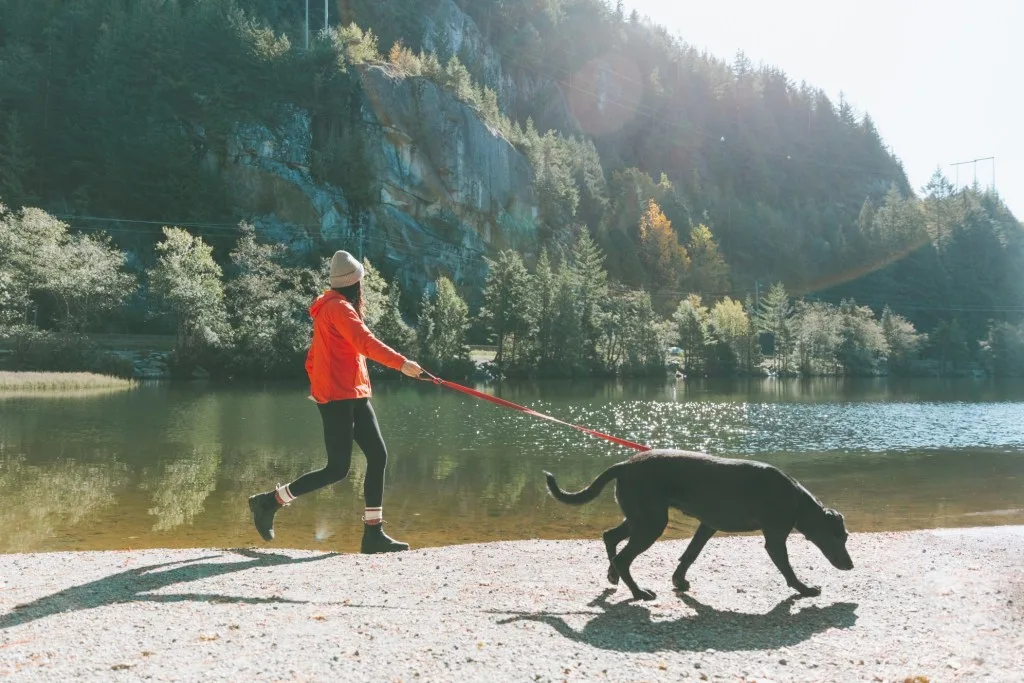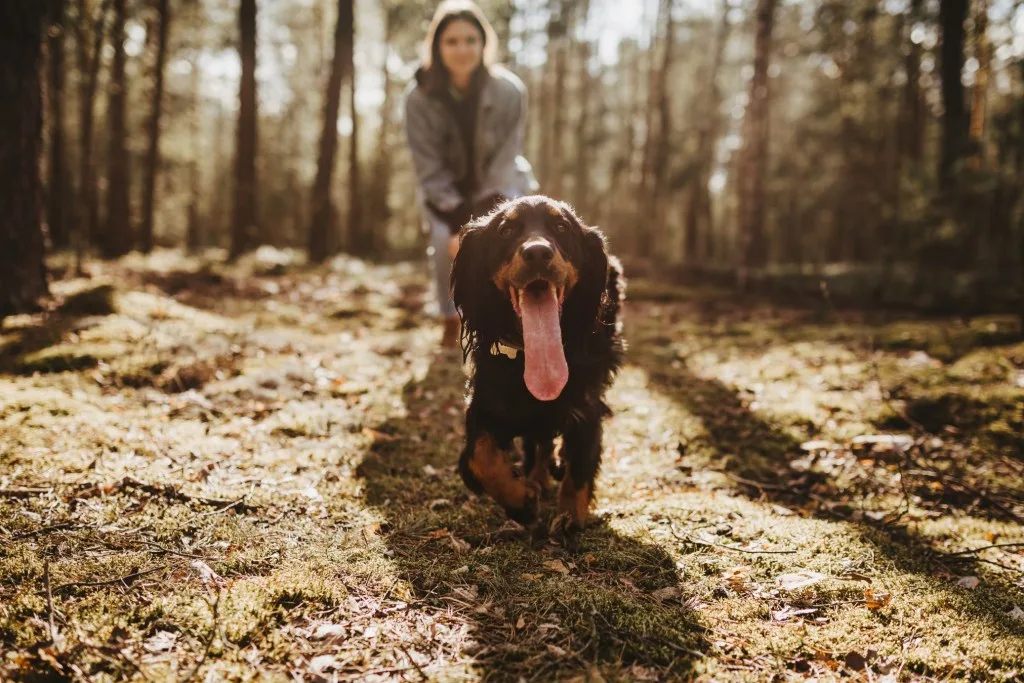Are Dogs Allowed in National Parks?
Is your dog allowed to join you on your bucket list trip to Grand Canyon or Yosemite National Parks? When Fido’s your best friend, you definitely want him as your wingman on a road trip!
But what happens when you visit destinations that don’t recognize canines as all-important traveling companions? It’s a valid question and one that doesn’t have just one answer in the case of national parks.
Let’s dig in a little more!

Are Dogs Allowed In National Parks?
The blanket answer to the question above is “Yes,” but it comes with an addendum. National Parks will often allow dogs in certain areas, such as campgrounds, but many don’t allow them on trails.
To find a specific answer, you’ll have to contact individual parks, as their responses vary regarding pet behavior on properties.
Even though their general policy isn’t terribly encouraging, the National Park Service has created a program just for visiting dogs. Many national parks and monuments have BARK Ranger Ambassadors, teaching pet owners proper etiquette for their dogs. BARK stands for Bag your pet’s waste, Always leash your pet, Respect wildlife, Know where you can go.
These ambassador dogs are volunteers that set a great example for the best way to enjoy a national park. They also encourage you to register your pooch as a BARK Ranger by learning the pledge. The park will even issue you a badge! BARK programs are opening at more and more parks each year.
So check to see if the ones you plan to visit have a BARK Ranger Ambassador on staff, then register your own pet as one.

Dogs Are Allowed In Most National Parks, But Not On Most Trails
Almost all national parks and monuments will allow you to bring your dog along. However, many won’t let your pet go on trails or even wander very far outside your vehicle. In fact, some parks may limit your dog to “doing his business” on the shoulder of a road.
Others allow only a short walk around the parking lot. If you’re planning a visit, be sure to check the park’s website to see their rules on pet allowances.
Why Aren’t Dogs Allowed in National Park Trails?
America’s national parks are usually created to protect and preserve specific geologic features and regions, monuments, buildings, and habitats. In most cases, this protection includes flora and fauna of that park. Allowing dogs to wander through these areas can do damage in a variety of ways.
Barking canines can scare local wildlife or attract predatory animals. Animals native to a park’s land are also vulnerable to diseases that some pets carry. In addition, fragile plant life is damaged by trampling or urination.
One of the most obvious reasons the national parks limit dog visits is for their own protection and the protection of park animals. No matter how much control a dog owner has, a man’s best friend can still break loose when suddenly surprised or approached by wildlife.
Aggression by a canine or local animals can end in tragedy on both sides.

Dog-Friendly National Parks
Several national parks have trails and spaces where dogs can roam with their humans (on a leash, of course). For some, there are gravel or dirt roads that aren’t close to wildlife areas.
Others, such as national historical parks and monuments, may have grasslands where owners can hike with their pets. Here are four national parks that provide many options for dogs to enjoy at their locations.
Acadia National Park
As with all national properties, Acadia enforces a six-foot leash law. In addition, it requires owners to pick up after their pets, asking them to take the ‘deposits’ outside of the park. They provide over 100 miles of hiking trails where dogs can get some exercise with their best buddies.
Three campgrounds within the park allow pets. However, most lakes prohibit people or pets from swimming because they’re water supplies, and the beaches are off-limits to dogs.

Congaree National Park
This park is totally accessible to dogs, allowing them on all of the boardwalks, trails, and campgrounds. The six-foot leash law is in effect, along with the requirement to pick up after your dog and not leave them unattended. Congaree is the perfect park to enjoy with your furry companion!
Grand Canyon National Park
Rover is welcome on all trails on top of the South Rim of the Grand Canyon. However, trails down into the canyon are off-limits to pets. They’re also forbidden on park shuttle busses and in lodging facilities, except pet-friendly rooms in Yavapai Lodge. The campgrounds and Trailer Village, as well as all developed areas, welcome canines.
On the North Rim, dogs can hike the section of the Bridle Path that connects with the North Kaibab Trail. They can also join you on the part of the Arizona Trail that heads north to the park entrance.
Grand Canyon NP requires all dogs to be on a leash no longer than six feet, and owners must pick up after their pets. Leaving them unattended is not allowed.

Shenandoah National Park
Shenandoah has over 500 miles of trails throughout their park, and only 20 miles do not allow dogs. So put this national park on your list of Fido-friendly destinations. Of course, your pet must be on a six-foot leash, and you must pick up after him.
But Shenandoah also suggests you have a plan in place for certain variables before you hit the trails together. For instance, does your dog have the stamina (and paw pads) to handle lengthy hikes? What will you do if he becomes injured on the trail? And how will he handle encountering a snake, skunk, or bear while hiking?
Anticipating problems with possible solutions will make your time together more enjoyable and safe.
Tips For Visiting National Parks With Your Dog
When planning a trip with your pet to any of the more than 420 units within the National Park System, we suggest you come prepared with the following.
Always Bring a Leash
Be sure to carry a leash no longer than six feet for your dog. No matter where you travel, your pet needs a good walk regardless of where they can take that walk. Most parks that don’t allow dogs on pathways still give a grace allowance within 100 feet of any road while on a leash.
That leash is also mandatory for campground stays and other public places that might welcome your best buddy.

Be Aware of the Rules
Each national park has its own set of rules, so take the time to look them up individually. One of the easiest ways to find out if Fido will be allowed is to Google “Pets in _____________” (fill in the park of choice.) You’ll find specific do’s and don’ts that will help you make a plan for your pet while you enjoy our national parks and monuments.
Never Leave Pets Unattended
Pet owners aren’t allowed to leave their dogs alone under any circumstances, even if they’re tied up. In fact, you will find that many states have enacted laws that don’t allow visitors to leave their pets alone in cars. Lawmakers passed the legislation to protect animals from suffering in hot vehicles.
However, a great number of RVers have found a way around this rule by running the air conditioner in their rig while they explore the park’s attractions.
Always Clean Up After Your Pet
It should go unsaid that all pet owners are responsible for cleaning up the “packages” their pets leave for them. But there is always someone who doesn’t bother, leaving messes for others to drive through, step in or track home.
It’s that person who ruins the experience of pet owners everywhere, causing venues to disallow dogs in the future. Don’t Be THAT Person!
Pro Tip: Being a bad dog-owner is one of our 7 deadly sins of camping.
Dogs Are Allowed in Most National Parks – With Limits
Most of us with dogs treat them like a part of the family, meaning they come along with us on family trips. And if that journey takes us to Zion or Shenandoah, we’d be letting Rover down if we didn’t research which parks provide more freedoms for him versus which might require him to stay in the RV.
Don’t arrive without knowing the answers, for your sake and your dog’s.
Discover the Best Free Camping Across the USA
To be honest with you, we hate paying for camping. There are so many free campsites in America (with complete privacy).
You should give it a try!
As a matter of fact, these free campsites are yours. Every time you pay federal taxes, you’re contributing to these lands.
Become a FREE CAMPING INSIDER and join the 100,000 campers who love to score the best site!
We’ll send you the 50 Best Free Campsites in the USA (one per state). Access the list by submitting your email below:
There are more – many more. And many national parks are surrounded by national forests that allow for similar experiences as the parks with more dog friendly trails. https://www.gopetfriendly.com/blog/best-dog-friendly-national-parks/
Besides protecting the local wildlife another good reason for not allowing dogs on trails is that people hike trails hoping to spot local wildlife, not your dog! The scent of your dog would have them running away from the trail as it’s the scent of a predator..
If you do bring your dog to a park, learn how to open the bear proof trash cans so you can deposit any filled dog waste bags in the can and not just leave it sitting on top. The number of dog owners who leave those bags sitting on the lid of the trash can instead of figuring out how to open it serves as proof that many dogs are probably smarter than the people who own them.